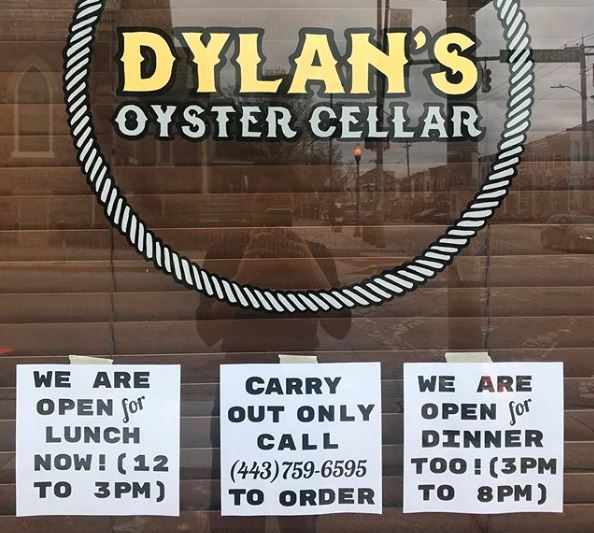
While some restaurants have temporarily closed for business in the wake of the COVID-19 crisis, others, per Governor Larry Hogan’s directive, have gone into survival mode by staying open for curbside and carryout.
To talk about what it’s been like to pursue this new business model, we checked in with Irene Salmon, co-owner of Dylan’s Oyster Cellar in Hampden. In addition to trying to make ends meet, the emotional toll has been toughest, says Salmon.
“We are social people—we are restaurant people,” she says. “We miss our staff and our customers. We are used to seeing 100 people a day. The restaurant is an empty shell—that has been the hardest part for us.”
What has life been like for you and your staff since Governor Hogan closed restaurants and bars?
We are hanging in there. [Two weeks ago] was really wild—we had to totally overhaul our business model and lay off half of our staff. We went from being a thriving business to a failing one overnight. Every restaurant I talk to is in the same position.
From the looks of your social media account, where you and your staff are waving flags and doing Chuck Norris-style kicks as a way of advertising that you are open, it looks like you’re trying to keep it light.
We are trying to have as much fun as we possibly can and put out funny messages on the internet—maybe that’s just an avoidance. We are definitely a ship at sea. To be frank, we are bringing in a third of the income we are used to bringing in—that will only pay for what’s remaining of our payroll and food costs.
We still have $21,000 of fixed expenses—that’s rent, it’s the BGE bill, it’s Comcast, our linen company, and cleaning products, and things like that—and we are sitting on a little bit of savings, which puts us in a better position than other restaurants, but it’s not much without help. We are applying for the Maryland Relief Grant Program—that’s for up to $10,000—but that would only scratch the surface.
I think as people become more cautious and know more people who get sick, it will drop down even more, and also as people worry about their finances. I’m anticipating that. We are trying to find a new norm. It’s like we have fallen into a black hole and need to see what the new normal is.
“We went from being a thriving business to a failing one overnight.”
What changes have you had to make to the menu with this new carryout model?
We’re not doing oysters anymore, which is a shame. They are too perishable, and we don’t have enough business to sustain the volume. This is hurting our distributors and farmers. It’s a whole chain reaction. We are doing a lot of burgers, fries, and catfish sandwiches. We are hoping to sell a fried oyster sandwich. We are trying to differentiate ourselves. Everyone has a burger and fries.
How are you handling your carryout?
We have our little side door set up. People can enter and swipe their own credit cards, and we have their food ready. We change our gloves often and we are constantly sanitizing surfaces. [Three] weeks ago, when the restaurant was open, I was like, ‘There’s no way to maintain this level of cleaning with the volume of people.’ We were thankful that Hogan put the [order] in place—that takes a lot of pressure and guilt off us. The Sunday before he made the announcement, we were like, ‘This is starting to feel too scary.’
Did you offer carryout prior to this?
No, we never allowed carryout food. In fact, people would get angry about it. But when we have a full restaurant, our priority has to be our customers who are seated. Now, I’m thinking that everyone’s wish can come true—and everyone can get their soft crab sandwich to go. I’m hoping soft crab sandwiches can save our restaurant—I’m hoping that maybe the crabs can start shedding their shells a little sooner…
“We are trying to find a new norm. It’s like we have fallen into a black hole and need to see what the new normal is.”
What’s it like being in the empty space?
People are so deprived of human interaction. When that synergy is back, it’s going to be wild. Maybe I took a little bit for granted when we were so busy. At the same time, I’m like, ‘This is the saddest thing to walk into an empty restaurant.’
How is your staff doing?
We are always telling jokes. We have the most awesome staff—even the staff members who are gone are not really gone. We’ve been doing giant group texts. We are restaurant people—this is hard for us emotionally—what we are feeling is grief, and some people have never experienced grief before.
